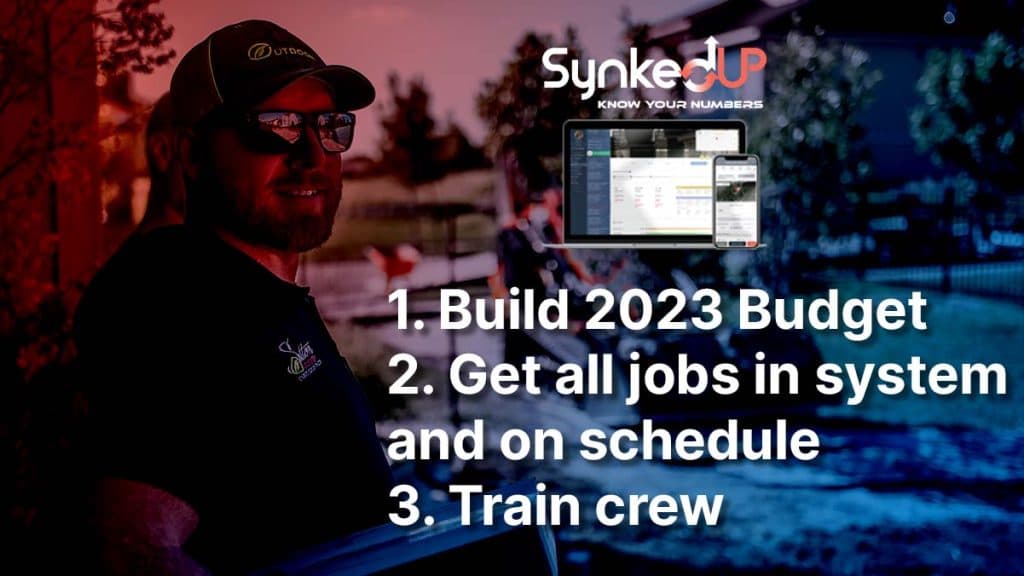I started a new series in my last blog, of “What to focus on in the off-season.” I’m continuing that today to focus on the second point of getting all of your jobs into your system and schedule.
If you haven’t already, that is. If you have good systems and processes in place, this is likely already done. If you are just starting to use a new system, like SynkedUP, for the first time this year, then this is especially for you.
Below is the list I’m working through for this series. I talked about the importance of building a company budget for your 2023 season in last week’s article. Check it out here. That article trumps all the other articles I’ll write in this series.
- Build your 2023 Budget
- Get your sold jobs and schedule all populated out for the year in your system & calendar
- Train your crew on new processes in the upcoming year

Focus on getting your sold jobs & schedule ready and set
The reason this point popped into my head when I thought about “what to do in the off-season” is a lot of people are upgrading their systems this time of year and may be using software for the very first time. Or they may be trying to use the one they have better and more efficiently.
And what I saw happen in the past is, they’d buy the system, and only enter jobs that they sold from here on out. And left the jobs they had already sold in their old systems and never brought them into the new system and schedule. And then complain that it wasn’t useful for them. 🤦♂️
Baffling to me. But it happens.
So, this is a reminder that whatever system you choose to use, it’s only as good and effective as you use it.
Leverage it.
So, what to do: Get all of your jobs into the system, and then get them all on the schedule. That’s step one. As you get them on the schedule, just remember to leave room for rain delays, upsell add-ons to jobs, etc.
Once you’ve done that, then I’d recommend going back and making sure each job has good notes, photos, all the material lists are accurate so the crew can depend on the system. So they can rely on it as a “source of truth” so they don’t have to call you to find out what posy to plant. Reduce phone tag. Leverage the power of the system to make life easy for your crews. (And yourself by default)
If you already have all your jobs and schedules set for the year
If you are already using a software system, then this is likely already in place and ready to roll for you. You may think you don’t need to focus on this one. But even so, I would still recommend that you have a team meeting like I described in the last article, and ask for input on how you could make your job planning, operations, and scheduling work better for your team.
It could be something as simple as the crew would like to see “before” photos in each job, and so you go back through your phone, find the photos, and upload them to your jobs so the crew can see them in their Digital Job Folder.
Or I’ll tell you a story of another one I remember we did a change on when I was at Tussey.
When the sales/designer at Tussey would sell one of our water feature kits, they would place an order at our supplier for all the parts and pieces. The supplier had record of all the kits we sold, so it was easy for them to just select the kit, and print out a PDF of the entire order. The supplier would give the designer/sales guy the PDF of the order sheet, and they would just upload that entire PDF into the job. Then in the items list of the workarea in SynkedUP they would just have one line that said “Pond parts from supplier, $——”
It was easy for the salesperson.
Improve crew lives
But I hated that as a foreman.
Because first, I couldn’t see the material list in the app in the materials section. In the materials section, it just read “pond parts from supplier”. To see the materials list I had to go to attachments, open a PDF, and zoom in so I could read on my phone screen. Oh, and if anything had changed, it was now out of date.
So, what we the crew asked for is, can you please just add all the materials (as they should be added) in the workarea, so we can see them in the mobile app, and if things change, well then it’s updated live.
The sales guys’ objection to that is there are a LOT of tiny parts and pieces in a water feature job. It took too much time to add them all in.
So, what do you think we did as a solution?
We built templates of all our standard water feature kits in SynkedUP, so all the sales guy had to do was drag and drop a template into the workarea, tweak anything that needed tweaked, and bingo, everybody had best of both worlds.
That’s what I’m talking about when I say you should focus on:
- ask your team for input on how you can make their lives easier
- then prep all your jobs, plan all your operations to implement those good ideas
Every man-hour you save adds more to the bottom line. Every truck run back to the shop eliminated adds to the bottom line. Every fuel stop at the gas station, run to Lowes, run back to the supplier to get the right part, eliminated, adds to the bottom line.
Which allows you to pay yourself and your team better.
And it will make lives easier for your crew. And the easier you make their lives by doing things like I gave in my example story from Tussey, the more it will inspire and motivate their buy-in to a system like SynkedUP. And motivate them to provide good feedback and ideas to continuously improve your operation.
If you have ever gotten resistance from the crew, ask them a genuine question: how can I make your lives easier?
Then do it.
That’s what a beautiful, productive, profitable team environment looks like.
Conclusion
If you want to explore using SynkedUP for your business this year, book a demo here. If you already have SynkedUP, and you would like to chat with your account rep on how you could better leverage the program, hit us up in the chat box on the lower right corner of this screen.
We’re not successful unless we can help you be successful.
Next week I’ll talk a bit about training your crew. Point #3 in my list at the beginning of this article.

Weston Zimmerman
CEO and co-founder








